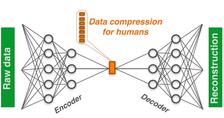General overview of the neural network (β-VAE-network): from raw data to reconstruction. (Image from authors: HZB)
Experimental data is often not only highly dimensional but also noisy and full of artefacts which makes it difficult to interpret them. Now a team from Helmholtz-Zentrum Berlin (HZB), together with scientists from DESY, University of Potsdam and University of Kassel, has designed software and tested it at FLASH. This software uses self-learning neural networks to compress the data in a smart way and reconstruct a low-noise version in the next step. It enables to recognise correlations that would otherwise not be discernible and has been successfully used in photon diagnostics experiments at FLASH at DESY.
But the software is suitable for very different applications in science. With highly complex data, which have many dimensions due to their numerous parameters, correlations are often no longer recognisable. Especially, since experimentally obtained data are additionally disturbed and noisy due to influences that cannot be controlled.
This new software based on artificial intelligence (AI) methods can help humans to interpret the data: It is a special class of neural networks (NN) that experts call 'disentangled variational autoencoder network' (β-VAE). Put simply, the first NN takes care of compressing the data, while the second NN subsequently reconstructs the data. In the process, the two NNs are trained so that the compressed form can be interpreted by humans.
Experts from 'Google DeepMind' have already proposed to use β-VAEs in 2017. Many experts assumed that the application would be challenging in the real world as non-linear components are difficult to disentangle. "After several years of learning how the NNs learn, it finally worked," says Gregor Hartmann, the first author of the paper from HZB. β-VAEs are able to extract the underlying core principle from data without prior knowledge.
In the published study, the team used the software to determine the photon energy of FLASH from single-shot photoelectron spectra. They succeeded in extracting this information from noisy electron time-of-flight data and much better than with conventional analysis methods. Even data with detector-specific artefacts can be 'cleaned up' this way.
The method is a powerful tool for different problems, for instance when it comes to impaired data. It is even possible to reconstruct tiny signals that were not visible in the raw data. Such networks can help uncover unexpected physical effects or correlations in large experimental data sets. In total, the development team spent three years developing the software and hopes that it can be used more or less 'plug and play'.
The AI-based data compression is a very powerful tool for future research not only in photon science.
(partly from HZB News 2022)
Reference:
Gregor Hartmann, Gesa Goetzke, Stefan Düsterer, Peter Feuer-Forson, Fabiano Lever, David Meier, Felix Möller, Luis Vera Ramirez, Markus Gühr, Kai Tiedtke, Jens Viefhaus and Markus Braune, "Unsupervised realworld knowledge extraction via disentangled variational autoencoders for photon diagnostics", Sci Rep 12, 20783 (2022), DOI: 10.1038/s41598-022-25249-4







